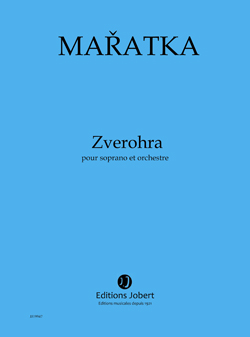ZVĚROHRA (Game of Beasts)
collection of anthropoid chants for soprano and orchestra
(2008)
Second part of the trilogy: OTISK, ZVĚROHRA, VÁBENÍ

Duration: 20’
Commissioned by Prague’s Premiers Festival and Radio France
Instrumentation: solo soprano, 1 piccolo, 2 flutes, 2 oboes, 1 cors anglais, 2 clarinets in B Flat, 1 bass clarinet in B Flat, 2 bassoons, 1 double bassoon, 4 horns in F, 2 C trumpets , 3 trombones, 1 tuba, 5 percussions, violins I, violins II, violas, violoncellos, double basses (strings minimum: 6-6-6-5-5)
Percussions in detail:
Perc.1: bass drum, vibraphone, snare drum, claves, slide whistle (app. 30 cm), vibraslap, tambourine, wood block
Perc.2: 2 tom-toms (low and medium), bongo, Snare drum, 3 gongs ageng (upwards: low E, low F #, low B), slide whistle (app. 30 cm), tambourine, washboard, kazoo
Perc.3: tam-tam, bongo, 2 pebbles, slapstick, tambourine, kazoo, claves
Perc.4: 2 timpani (F-B, C-F), 2 congas, suspended cymbal, slapstick, 2 pebbles, tambourine, maracas, kazoo
Perc.5: marimba, 2 congas, suspended cymbal, wood chimes, 2 pebbles, tambourine, kazoo
Premiere: Elena Vassilieva (soprano), Czech Philharmonic Orchestra, Michel Shwierciewski (conductor), April 4th, 2008 at Prague's Premieres Festival, Rudolfinum Hall, Prague
Publisher: The Henry Lemoine Editions display more information on this work on http://www.henry-lemoine.com/fr/compositeurs/fiche/krystof-Mařatka
For more information, contact:
Henry Lemoine Editions – Paris
Mrs Laurence Fauvet - Rental and purchase of score
orchestre@editions-lemoine.fr / +33 (0) 1 56 68 86 75
Jobert Editions
Henry Lemoine Editions – Paris
Mr. Benoît Walther - Promotion and distribution service
bwalther@editions-lemoine.fr / +33 (0) 1 56 68 86 74
Jobert Editions
Recording:
Elena Vassilieva, soprano / Orchestre Colonne / Kryštof Mařatka, conductor
Extract from the score:
Notes on the work:
Zvěrohra (Game of Beasts), collection of anthropoid chants, is a logical follow up to my composition for large symphonic orchestra Otisk (Imprint), Paleolithic Site of Pre-instrumental music (2004), which presents a utopian vision spanning from the origins of music to the sound of instruments of the Paleolithic era, about 50,000 years ago. Zvěrohra pushes this mirror of time even further back: the work reflects the phenomenon of the first vocal expressions and of the development of our distant ancestors’ language.
The fundamental idea of Zvěrohra is based on the interaction between the sound universe of animals, their imitation, and the acquisition of the potential of one’s own human voice. A smooth flow of instrumental, and above all vocal elements is bearing the architecture of the piece, which is essentially a segmented ritual, reminiscent of a game of discovery of the possibilities of sound communication at the dawn of the human species. The work evokes the primitive vocal expressions of the first hominids who begin to discover other possibilities of communication than their gestures: a complex set of vocal sounds to which they attribute concrete meanings.

